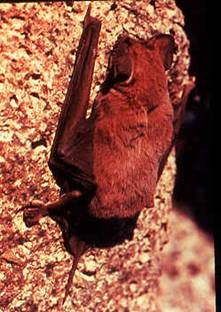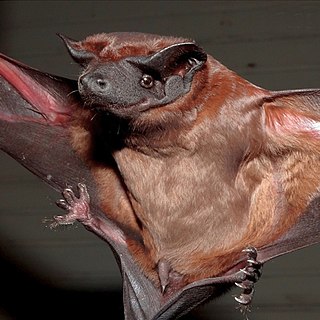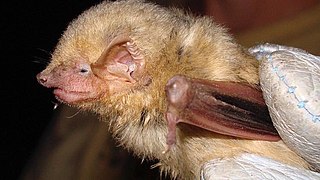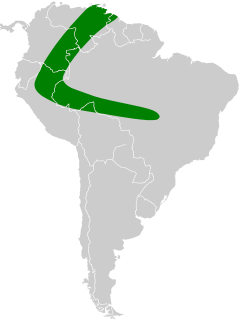
The Molossidae, or free-tailed bats, are a family of bats within the order Chiroptera. The Molossidae is the fourth-largest family of bats, containing about 110 species as of 2012. They are generally quite robust, and consist of many strong-flying forms with relatively long and narrow wings with wrinkled lips shared through their genus. Their strong flying form allows them to fly 60 miles per hour using tail winds and at altitudes over 10,000 feet. This makes them unique among bats, as they are the only bat family that withstands the elevation. They are widespread, being found on every continent except Antarctica. They are typically found in caves, abandoned mines, or tunnels.

The hairy-legged vampire bat is one of three extant species of vampire bats. It mainly feeds on the blood of wild birds, but can also feed both on domestic birds and humans. This vampire bat lives mainly in tropical and subtropical forestlands of South America, Central America, and southern Mexico. It is the sole member of the genus Diphylla.

The cinnamon dog-faced bat, is a South American bat species of the family Molossidae. It is found in northern and central South America.

The southern dog-faced bat, is a bat species of the family Molossidae. It is found in northern Argentina, Bolivia, Brazil, Colombia, French Guiana, Guyana, Panama, Peru, Paraguay, Suriname and Venezuela.

The rufous dog-faced bat, is a bat species found in Argentina, Brazil, Colombia, Guyana, Peru and Suriname.

The dwarf dog-faced bat is a species of free-tailed bat from South America. It is found in Argentina, Bolivia, Brazil, Colombia, Ecuador, Guyana, Peru, Paraguay and Uruguay, typically at lower elevations. It is one of two species in the genus Molossops, the other being the rufous dog-faced bat. Three subspecies are often recognized, though mammalogist Judith Eger considers it monotypic with no subspecies. It is a small free-tailed bat, with a forearm length of 28.9–32.5 mm (1.14–1.28 in) and a weight of 5–8 g (0.18–0.28 oz); males are larger than females. It is brown, with paler belly fur and darker back fur. Its wings are unusual for a free-tailed bat, with exceptionally broad wingtips. Additionally, it has low wing loading, meaning that it has a large wing surface area relative to its body weight. Therefore, it flies more similarly to a vesper bat than to other species in its own family. As it forages at night for its insect prey, including moths, beetles, and others, it uses two kinds of frequency-modulated echolocation calls: one type is to navigate in open areas and to search for prey, while the other type is used for navigating in cluttered areas or while approaching a prey item.

The Para dog-faced bat, also called the brown dog-faced bat, is a South American bat species of the family Molossidae. It is found in Panama, Colombia, Ecuador, Peru, Venezuela, Guyana, Surinam, French Guiana, Brazil, and northern Argentina.

The white-throated round-eared bat is a South and Central American bat species found from Honduras to Bolivia, Paraguay and Brazil. It creates roosts inside the nests of the termite, Nasutitermes corniger. It thrives on a mainly insect-based diet, focusing on the surfaces of foliage to hunt, and also eats fruit and pollen. It has a very wide range and is a common species over much of that range, so the International Union for Conservation of Nature has assessed its conservation status as being of "least concern".

The great stripe-faced bat or stripe-faced vampire bat is a bat species from South and Central America, where it is found from southern Mexico to Bolivia and northwestern Brazil, as well as on Trinidad. The great stripe-faced bat is a frugivore. It is one of two species within the genus Vampyrodes the other being Vampyrodes major.

Greenhall's dog-faced bat is a South American bat species of the family Molossidae. It is found in Colombia, Peru, Ecuador, Venezuela, the Guianas, northeastern Brazil and Trinidad.
The Guadeloupe big brown bat is a species of vesper bat. It is found only on the island of Guadeloupe. It is one of the 11 species of bat found on Guadeloupe, and one of the 3 that are endemic.

Genoways's yellow bat is a species of vesper bat. It is found only in Mexico. It is threatened by habitat loss. Due to its imperiled status, it is identified by the Alliance for Zero Extinction as a species in danger of imminent extinction.

The western yellow bat is a species of vesper bat. It is found in Mexico and the southwestern United States. This species roosts in trees such as Populus fremontii, Platanus wrightii, and Quercus arizonica. If available, the western yellow bat will use the dead fronds that encircle palm trees as a roosting site.

The equatorial dog-faced bat is a species of bat in the family Molossidae. It is endemic to Ecuador. They are found in dry, tropical forests. The species is now endangered. The equatorial dog-faced bat feeds on insects.

Cynomops is a genus of Central and South American dog-faced bats in the family Molossidae. It has sometimes been considered a subgenus of Molossops. It contains the following species:

Cynomops milleri is a species of bat that is native to South America. It was previously considered a subspecies of the Para dog-faced bat. It is considered a small- to medium-sized member of its genus. It is classified as least concern by the International Union for Conservation of Nature because it appears to be common and widespread. It is found in Venezuela, French Guiana, Guyana, Suriname, Brazil, and Peru.

The Mexican greater funnel-eared bat is a species of bat found in Central America. While initially and currently described as a species, from 1959–2006 it was considered a subspecies of the Mexican funnel-eared bat, Natalus stramineus.

Eumops ferox, the fierce bonneted bat or the chestnut mastiff bat, is a species of free-tailed bat found in the Caribbean and Mexico. Until recently, it was synonymous with Wagner's bonneted bat.


















